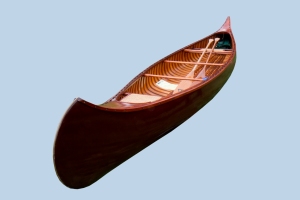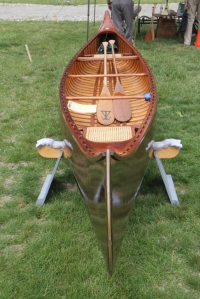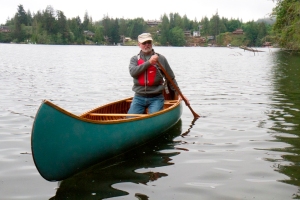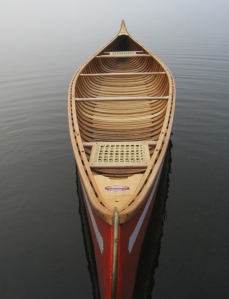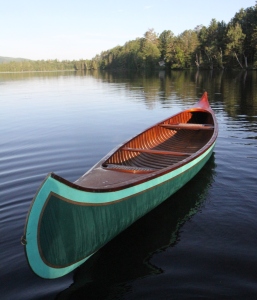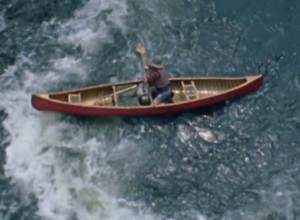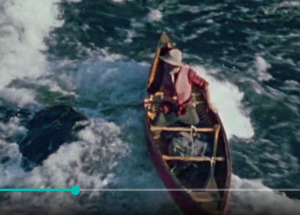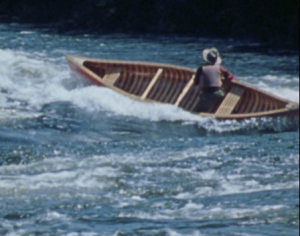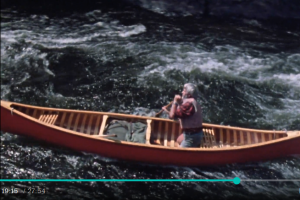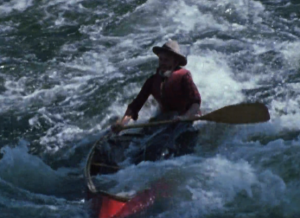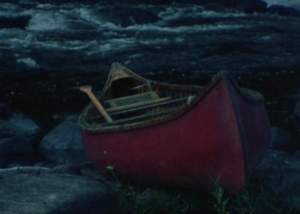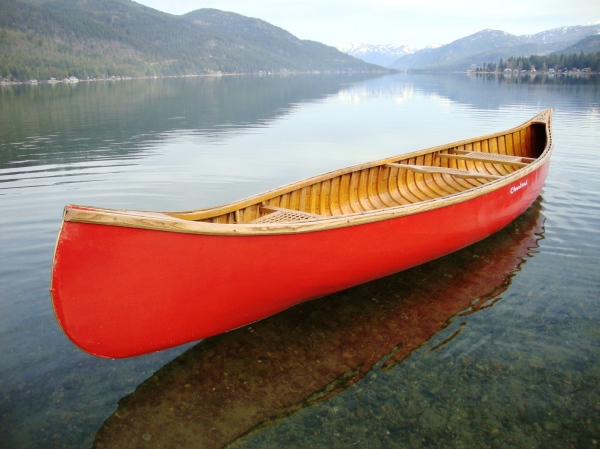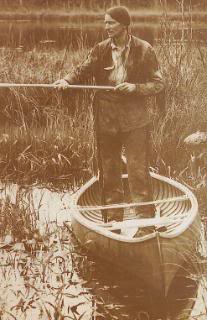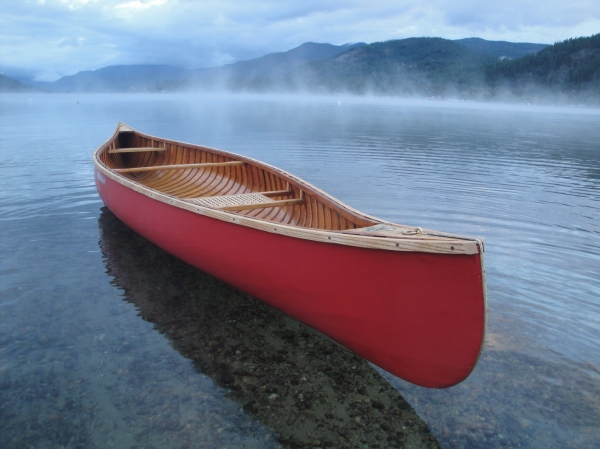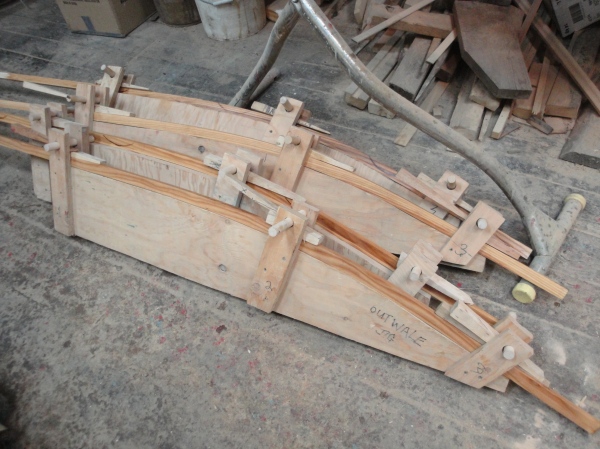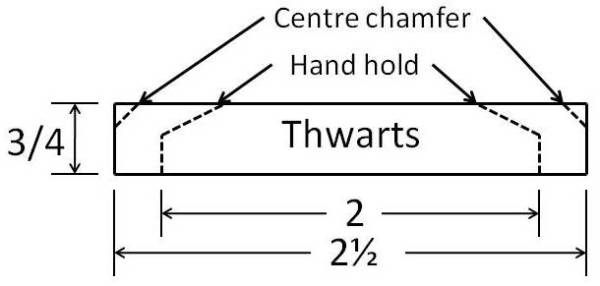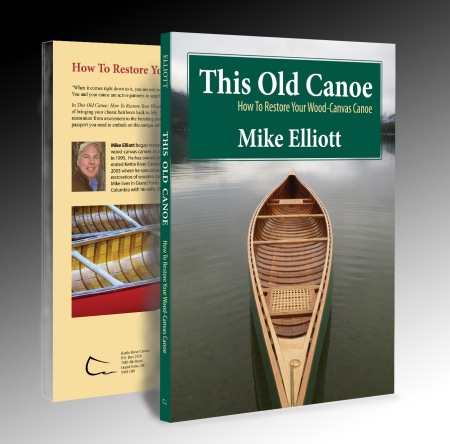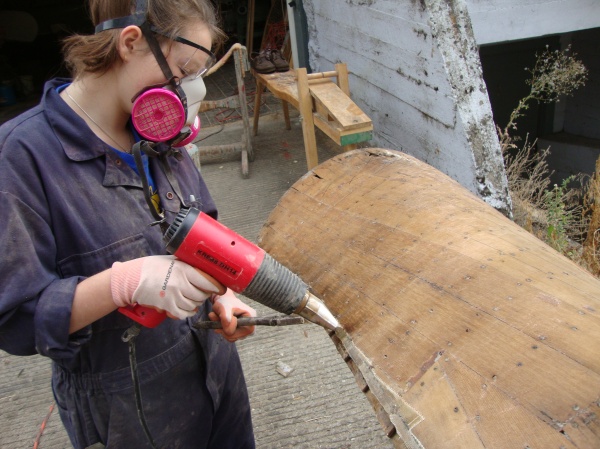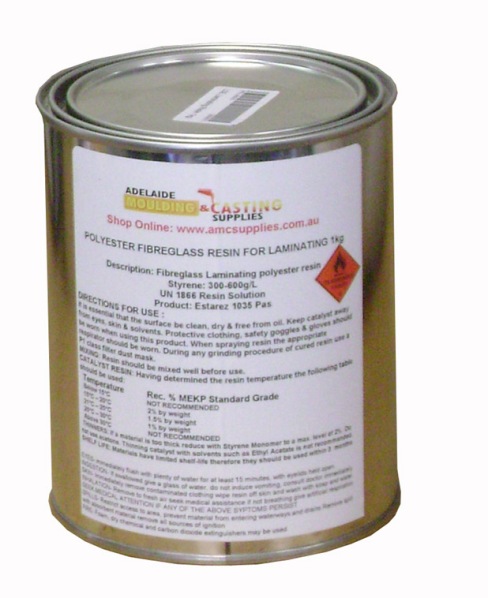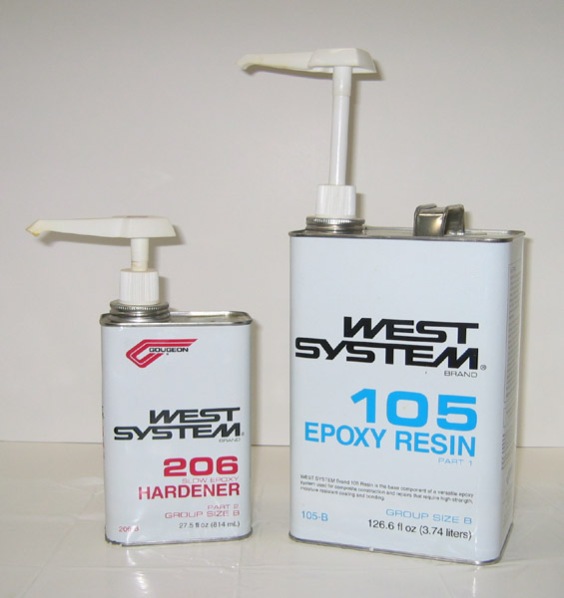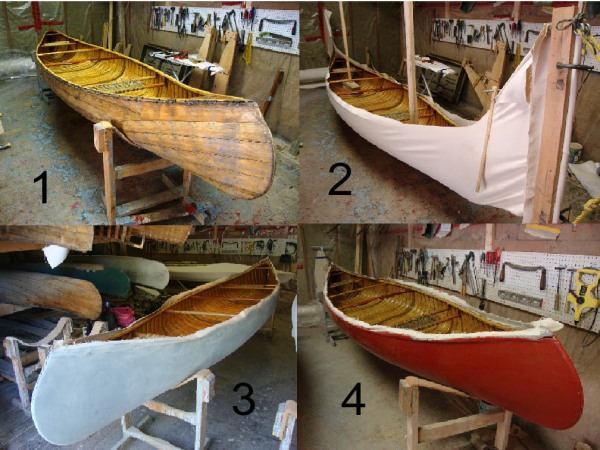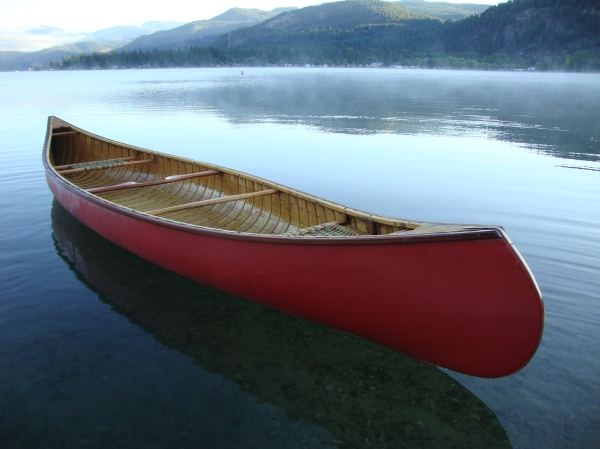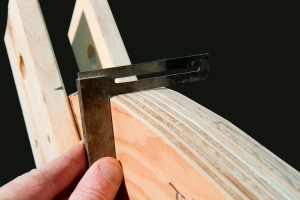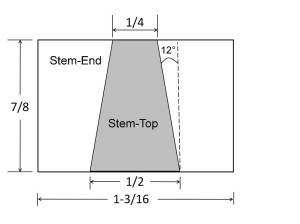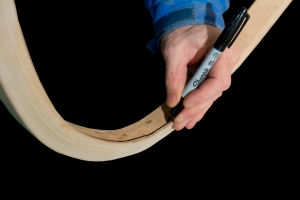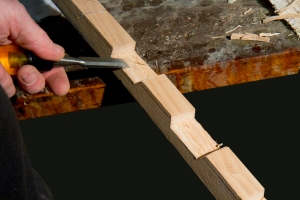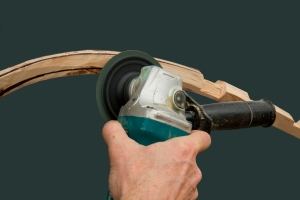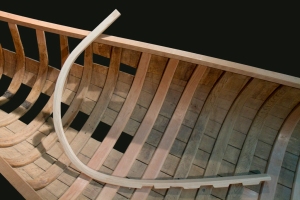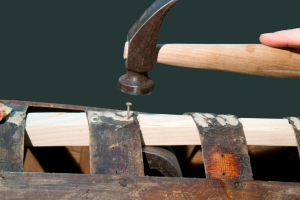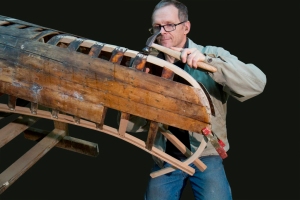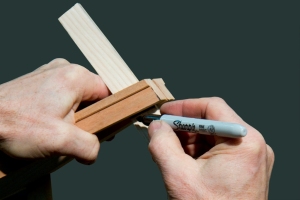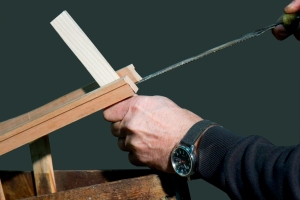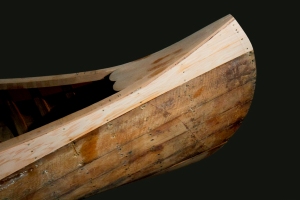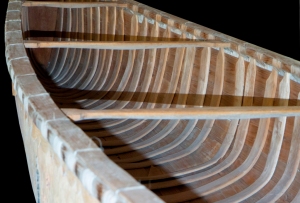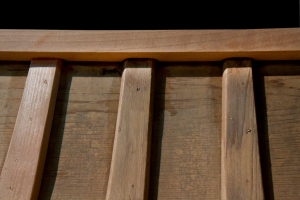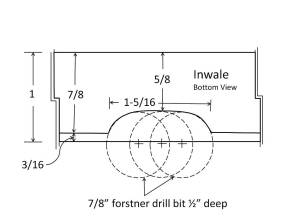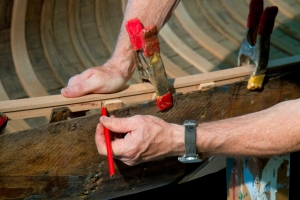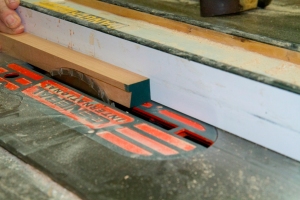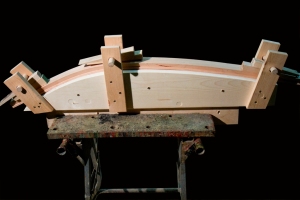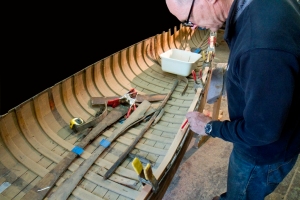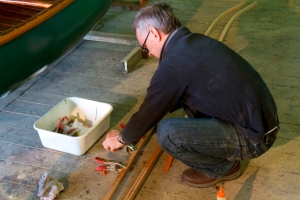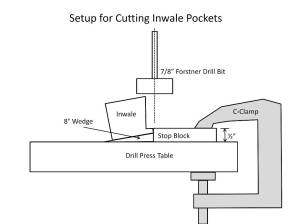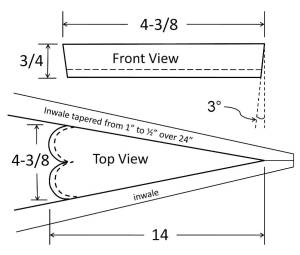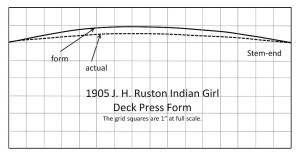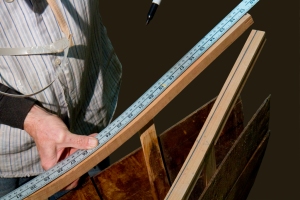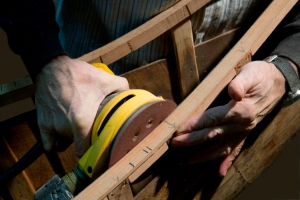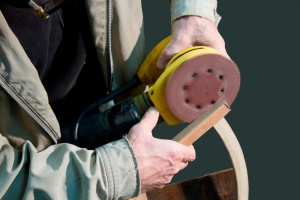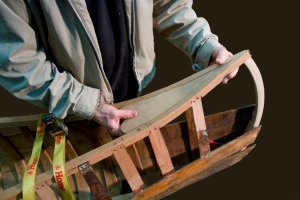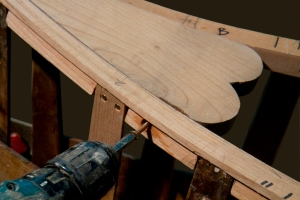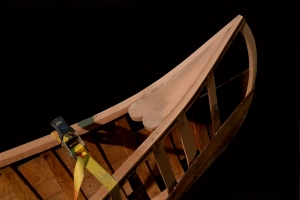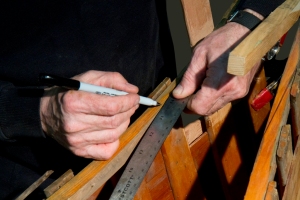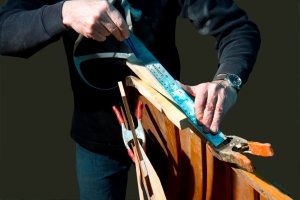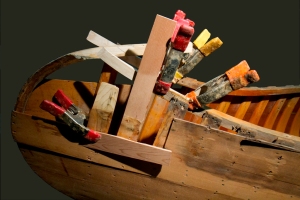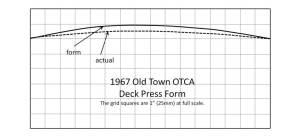Coming in July 2024: This Fancy Old Canoe: A Comprehensive Guide to Restoring Antique Canoes
April 8, 2024
by Mike Elliott, Kettle River Canoes
email: artisan@canoeshop.ca

This Fancy Old Canoe: A Comprehensive Guide to Restoring Antique Canoes picks up where This Old Canoe: How to Restore Your Wood-Canvas Canoe left off. Whether you are an avid collector of antique canoes or you have limited woodworking experience and just want to get your family’s heirloom canoe back on the water, the two books work together to provide the techniques necessary to achieve success in your canoe-restoration adventure.

Repairing antique canoes can be a supreme challenge because their artisans built them with beauty and longevity in mind. Using over 400 photos and more than 100 plans and illustrations, This Fancy Old Canoe is designed to simplify the restoration process, guide you through it, and provide a measure of clarity to these complex tasks.
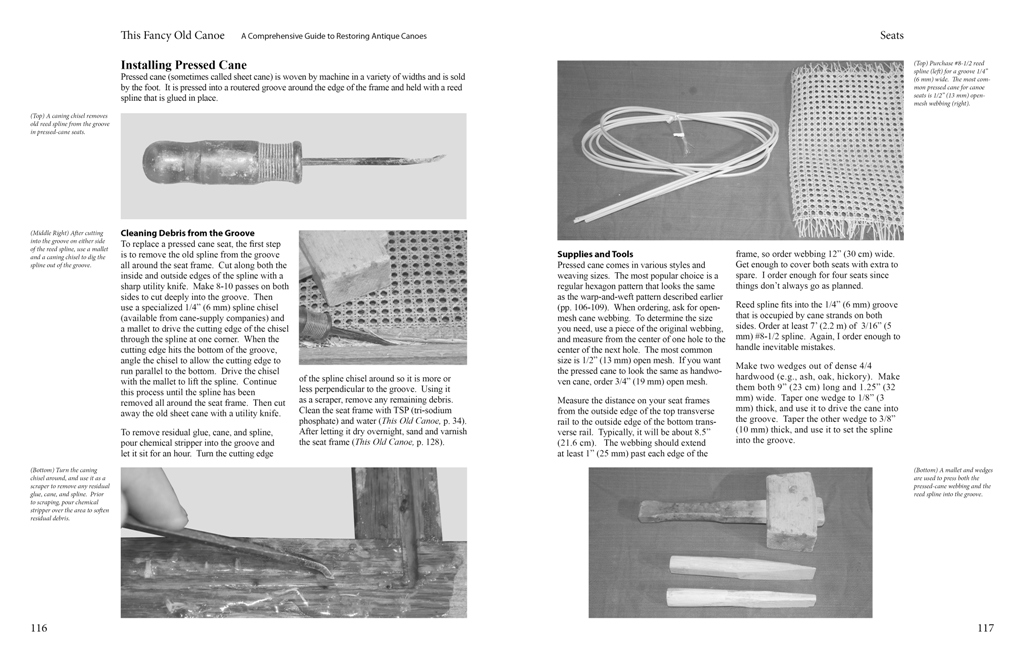
The book covers every aspect you may encounter in fancy old canoes, including:
- identifying your canoe and understanding its construction
- replacing and weaving cane seats
- reverse engineering highly curved ends
- removing and installing pocketed inwales, wide outwales, and sponsons (air chambers attached to the sides of the canoe)
- repairing sailing rigs and floor systems
- applying fancy hand-painted designs
- sourcing materials

Many antique canoes, built in the Peterborough region of Ontario, Canada, are all-wood construction. They do not have a canvas cover. Instead, they rely on precise joinery to create a water-tight hull. This Fancy Old Canoe describes how to repair and replace every component in these elegant examples of floating art.
This Fancy Old Canoe: A Comprehensive Guide to Restoring Antique Canoes will be available in July 2024. Stay tuned.
A Brief Guide to Canvas-Covered Old Town Canoes
December 6, 2019
by Mike Elliott, Kettle River Canoes
email: artisan@canoeshop.ca
In America, the Old Town Canoe Company set the standard by which all other canvas-covered canoes are measured. With more than 170,000 produced over the course of seven decades or more, Old Town canoes are ubiquitous. So let’s look at a few of their classic models and compare them. From this, you ought to be able to identify your Old Town. However, be prepared for any American canoe to be called an Old Town.
The Old Town Canoe Company
The brand-name Old Town is synonymous with canvas-covered canoes in the United States. They are one of the only canoe companies to survive into the present day from their humble beginnings behind the Gray hardware store in Old Town, Maine in 1898. George and Samuel Gray incorporated the Old Town Canoe Company in 1901. They were entrepreneurs who hired others to design and build their canoes. The company kept meticulous build records which are still available through the WCHA. Their designs appealed to customers across the full range of styles from work-a-day canoes to elegant showpieces. So, let’s look at some of these quintessential canoes.
The Otca Model
Probably the best selling of all the Old Town models, the Otca was introduced in 1908 and began with a narrow hull (34.5” beam in the 16’ length) and later adopted the wide, flat-bottom of the Yankee model (36” beam in the 16’ length). According to their 1938 catalog, “The ‘Otca’ model is the widest, deepest and roomiest. These features make it the steadiest, safest and most capacious canoe we build. The floor is flat and wide, and carries far into the ends. The sides are convex, thus producing a handsome tumblehome. This model is not designed for speed but comfort, safety and fine appearance.”
The Otca caters to novice canoeists as well as those looking for a leisurely day on the water. There is little to no rocker at the ends, so it tracks very well. As a friend of mine explained, “It goes in a straight line. If you want to turn, just paddle until you reach the opposite side of the lake, get out, turn the canoe around and head back.”
It comes in 16’, 17’ and 18’ lengths and usually has a floor rack installed. It sports elegant, up-swept ends with a variety of deck styles over the years including a 16” solid-wood, pre-bent deck, a 20” one-piece deck with a low coaming and a 30” framed-veneer deck with a king-plank and coaming. The ribs in the Otca are standard-issue (5/16” thick, 2” wide spaced 1.5” apart and tapered on both sides to be approximately 1.5” wide at the sheer-line). The 16’ model weighs approximately 75 pounds.
The Yankee Model
This canoe (known as the Livery Model prior to 1920) was phased out in favour of the Otca in the 1940’s. It is a very easy paddling canoe. The flat bottom and soft chine makes it both steady and quick. It is 16’ long, 36” beam, 12” deep and weighs approximately 73 pounds. With fine entry lines and moderate rocker at the ends, it is a delight to paddle.
The Ideal Model
The Ideal comes in 16’ and 17’ lengths. It has a flat bottom, soft chine, straight sides, moderate rocker and fine entry lines making for a quick, responsive canoe. The floor is furnished with half-ribs to make it strong and comfortable. The ends sweep up with an elegant rise in the sheer-line. It is a quick, easy paddler and becomes more stable as it is loaded.
The Charles River Model
This canoe (introduced in 1903) is the same as the Ideal without the half-ribs. It was often furnished with a floor rack and was built with elegance and showy good looks in mind. That said, its flat-bottom, soft chine and fine entry lines produce in a canoe that was just as much fun to paddle as it was a delight to look at. Both the Ideal and Charles River were phased out in 1929.
The Guides Special Model
This is a slow, steady work-a-day canoe that comes in 18’ and 20’ lengths. The 18’ model has a 36” beam and is 13” deep. It has a flat-bottom, slight tumblehome, very little rocker and full ends. This workhorse is meant to be loaded and will get you where you want to go. Just don’t expect to get there quickly.
The H W Model
The Heavy Water Model is the consummate back-country traveler. It has moderate rocker, a semi-arch “yawl” hull, mild tumblehome through the entire length and full ends. With a narrow beam, this canoe is very quick on the water. Stability is traded for a canoe which is agile and responsive. It takes a little getting used to and once you do, it dances through river rapids. In my books, it is a delightful recreational canoe. The 16’ model has a 33” beam, is 12” deep at the centre and weighs about 70 pounds.
The 50-LB. Model
The “50-Pounder” is a series of light-weight versions of the HW model. They come in 11’, 13’ and 15’ lengths and weigh 50, 53 and 58 pounds respectively. They are constructed with ribs ¼” thick to produce canoes which are easy to portage. Modest tumblehome extends the entire length of the canoe and the bottom has a semi-arch and fine entry lines. The result is a versatile all-purpose canoe. Personally, I enjoy the 15’ model. It is light, quick and both steady and agile to handle rivers and lakes with ease.
by Mike Elliott, Kettle River Canoes
email: artisan@canoeshop.ca
The blogs I do on the specifications of canoe components for various types of canvas-covered canoes seem to be quite popular. Apparently, I am the only one out there taking the time to write about this stuff and share it with others on-line. This time around, I am presenting a restorer’s guide to the Bobs Special from the Chestnut Canoe Company.
This canoe was one of two lightweight pleasure canoes built by Chestnut (the other was an 11’ solo canoe called the Featherweight that weighed about 38 pounds). Before I talk about the canoe, I’d like to clarify the name. According to Roger MacGregor in his book When the Chestnut was in Flower, Henry and William Chestnut were real history buffs. The telegraph code for the 15’ 50-Lb. Special was BOBS and made reference to Lord Roberts, a major figure during the Second Boer War in South Africa. Over the years, as this wide, light-weight canoe became more difficult to keep under the weight limit of 50 lbs. (the average weight was 58 pounds while the carrying capacity was 700 pounds), they changed the name. I have seen a variety of Chestnut catalogues call it Bob’s Special, Bob Special and Bobs Special. So, feel free to take your pick.
If you happen to have a Bobs or have been lucky enough to come across one in need of some TLC, you will notice what a sweet little canoe this is. It paddles like a dream which is surprising for a canoe that is 37” (94 cm) wide. Its bottom has a shallow-arch that reduces the waterline width when paddled with a light load. There is a fair amount of rocker in the ends which adds to its maneuverability. At the same time, it is not difficult to stand up in a Bobs – making it ideal for fly-fishing or general recreational paddling for a less experienced paddler.
One little note here: I am listing all of the dimensions in inches. I apologize to all of you who are working in metric. The canoes were built with imperial measurements originally, so I find it easier and more accurate to stick with this measurement scale.

Inwales –The inwale is a length of White Ash or Douglas Fir 15/16” high with the edge grain visible on the top surface. It is fashioned to fit the tumblehome present on most Chestnut canoes. Therefore, the top surface is 9/16” wide while the bottom width is 11/16”. The last 18” or so at each end is tapered down to about ½” wide (top and bottom) along the sides of the decks. All of the transverse components (centre thwart and seats) are attached to the inwales with 10-24 (3/16”) galvanized steel carriage bolts. I replace these with 10-24 silicon-bronze carriage bolts.
The gunwales (both inwales and outwales) are pre-bent about 18” from the ends. If you are replacing these components, the wood will have to be soaked for 3 days, heated by pouring boiling water over them and bent onto custom-built forms in order to get a proper fit.
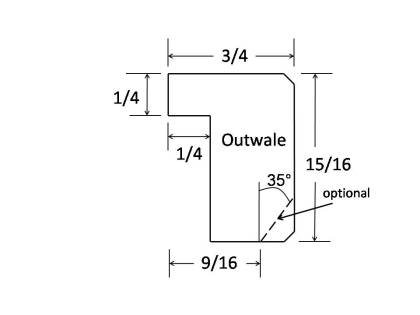
Outwales – The outwales are also made of White Ash or Douglas Fir. Depending on when the canoe was built, the outwales may have a chamfered edge on the bottom of the outside surface. Water often gets trapped under the outwales and results in rot on the inside surface of the originals because they assembled the canoe first and then applied paint and varnish. Consequently, the inside surfaces of the outwales are bare wood. Therefore, I usually end up replacing this component. Prior to installation, I seal the wood on all surfaces with a couple of coats of spar varnish. Unlike the original builders, I do all of the painting and varnishing first and then assemble the canoe.
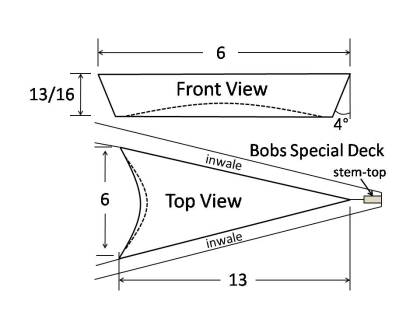
Decks – The decks the Bobs Special were made of hardwood – usually maple, white ash or white oak. Sometimes, they used mahogany to help reduce the overall weight. By the time you start restoring your canoe, the decks are often rotted along with the stem-tops and inwale-ends. They are attached to the inwales with six 1¾” #8 bronze wood screws. As with the outwales, I help prevent future rot by sealing the decks on all surfaces with a couple of coats of spar varnish. The deck extends about 18” into the canoe from the end.
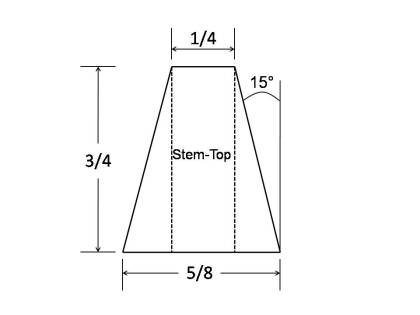
Stem-Top – You will rarely if ever have to replace the entire stem. However, I rarely see an original stem-top that is not partially or completely rotted away. Because the top 6” or so of the stem is straight, you can usually make the repair without having to pre-bend the wood to fit the original stem-profile.
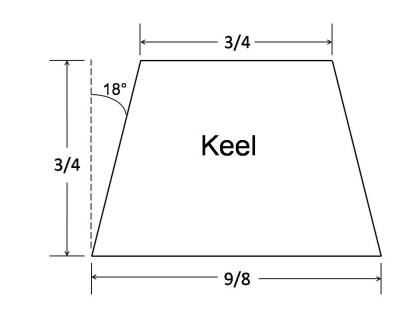
Keel – The Bob Special had a regular (tapered) keel installed. Use a piece of hardwood (the original was ash) and taper each end to 3/8” wide. The overall length is about 13’. It will accept the brass stem-band which is 3/8” wide.
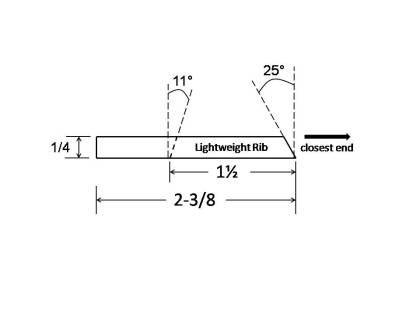
Ribs – The Bobs Special was constructed with so-called “regular” ribs (2-3/8” wide) that were ¼” thick instead of the normal 3/8”. They create a light-weight canoe but are not as robust as the regular ribs. You will probably encounter several broken ribs in your canoe restoration.
The edges of the ribs are chamfered in most Bobs Specials. Replicate the angles found in your canoe. Often, the edge closest to the centre of the canoe has tapered ends (11° chamfer) while the edge closest to one end of the canoe is chamfered about 25°.
Planking – The planking in Chestnut Canoes was made of either Eastern White Cedar or Western Red Cedar. Although the planks started out at 5/32” thick, you will probably be shaving replacement planks down to match the original planks. Again, this results in a lighter, less robust canoe. You will probably encounter many broken planks in your canoe.
Seats – The seat frames are made of ¾” ash, oak or maple that is 1½” wide. Both seats are suspended under the inwales with 10-24 carriage bolts and held in position with 5/8” hardwood dowel. The rear stern seat dowels are 1¾” long while the front dowels are ¾” long. All of the bow seat dowels are ¾” long. The forward edge of the bow seat is about 51½” from the bow-end of the canoe while the forward edge of the stern seat is about 39½” from the stern-end of the canoe.
Centre Thwart – The thwart is made of ¾” ash that is 2½” wide. It tapers from the centre to create handle grips on either side that are 2” wide. They were attached directly under the inwales with galvanized steel 10-24 carriage bolts. As with every component in the canoe, I seal the entire thwart with a couple of coats of spar varnish prior to installation and replace the original galvanized steel bolts with silicon bronze bolts.
All of this (and much more) is described in my book – This Old Canoe: How To Restore Your Wood Canvas Canoe.
If you live in Canada, CLICK HERE to buy the book.
If you live in the USA, CLICK HERE to buy the book.
If you live in the UK, CLICK HERE to buy the book.
Si vous habitez en France, CLIQUEZ ICI acheter le livre.
How to Remove Fiberglass from a Wood-Canvas Canoe
March 27, 2019
by Mike Elliott, Kettle River Canoes
email: artisan@canoeshop.ca
For those of you new to this blog and have not heard me on this topic before, let me be as clear as I can be: To anyone thinking about applying fiberglass to a wood-canvas canoe, I say, “DON’T DO IT!” To anyone wanting to remove fiberglass from a wood-canvas canoe, the short answer is: HEAT.
Wood-canvas canoes are a product of a by-gone era; a time before planned obsolescence — when things were built with the long term interests of the consumer in mind. The whole idea of building a canoe with wood and canvas was to have a vessel that lives and breathes. These canoes work in the natural environment and are part of it. They are held together with tacks and screws – no glue. The wood flexes and moves with the water around it. When part of the canoe breaks or rots, it can be repaired or replaced with comparative ease because it is designed to be taken apart and rebuilt. As long as there are people who know how to restore canvas-covered canoes, they will live forever.
It has been about forty years since these canoes were the standard in the marketplace. Not only has the technology of wooden canoe repair faded into obscurity, but the mindset of both manufacturers and consumers has also changed. Synthetic materials are now generally seen as better – easier, tougher and longer lasting. The consumer has been convinced that the new materials can improve that which is outdated or at least maintain it quickly and easily.
When it comes right down to it, wooden canoes and fiberglass just don’t mix. Since the ribs and planking are held together with tacks, they flex and move naturally. Over the years, the tacks tend to work loose and eventually have to be either re-clinched or replaced. Conversely, fiberglass resin is rigid. Once applied, it tends to resist any movement. The combination of a flexible hull and a rigid outside layer results in cracked or delaminated resin. The tacks can also wear against the resin from the inside to the point where they come right through the resin. It can take several months or several decades, but at some point the canoe needs to be repaired and the fiberglass has to come off. It is then that the real problem comes to light. All of that synthetic resin has to be removed. It is a long, painstaking process that usually has you cursing the person that put the stuff on in the first place. The moral of the story is: Avoid applying fiberglass to the hull of a wood-canvas canoe. Learn how to re-canvas the canoe or find a professional to do it for you.
This leads us into the next question: How do you remove fiberglass from a wood-canvas canoe? All you require is a professional-grade heat-gun, a 2” putty knife, a pair of pliers, safety equipment (work gloves, safety glasses and a respirator mask) and lots of patience. The first step is to move the canoe into a well ventilated work space – preferably outdoors. Then start at an edge of the canoe and apply heat to the resin.
At this point it is important to note that fiberglass resins come in two basic types – polyester and epoxy. Polyester resins were the first to be developed. If your canoe had fiberglass applied to it in the 1970’s or earlier, you can bet that polyester resins were used. They tend to become brittle and deteriorate rapidly, so if the fiberglass on your canoe is delaminating it is most likely that you are dealing with a polyester resin. Fortunately, this makes the removal of the fiberglass relatively quick and easy. In many cases, the cloth can be ripped off by hand with very little need for heat. When I say rip, please be gentle. If you get carried away and pull at the fiberglass cloth too rapidly, you could end up tearing sizeable chunks of planking off the canoe as well (I speak from first-hand experience).
Epoxy resins hit the market in a big way in the 1980’s and are the standard today. They are applied by first mixing a hardener with a resin in a two-part formula. What results is a strong, tough plastic that bonds very well to wood. Unfortunately, this means that the removal process is arduous and painstaking.

As mentioned earlier, start at an edge of the canoe and apply heat to the resin. If you are dealing with epoxy resin, you will probably have to apply the heat for several minutes before the cloth begins to respond to your attempts to lift it with the putty knife. At some point, it does let go and the fiberglass cloth can be separated from the canoe. Then move a few centimeters and continue the process. Again, polyester resins let go fairly quickly. You will find that large sheets of cloth come off in fairly short order. I usually grab the cloth with a pair of pliers rather than with my hand. Even with work gloves on, the pliers prevent nasty encounters with heat and/or sharp edges of fiberglass (again, this is the voice of experience talking).
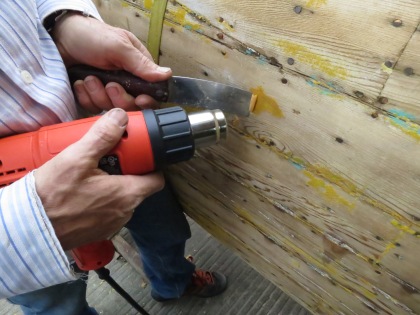
Once all of the fiberglass cloth is removed, return to the canoe hull with the heat gun and a putty knife. Apply heat to any patches of resin still stuck to the wood. Then, scrape the resin off. Be prepared to settle into hours of tedious work. It typically takes 15 to 20 hours to remove the fiberglass cloth and resin from a 16′ canoe.
Once you are back to the bare wood, the restoration is like that of any other wood-canvas canoe. So, enjoy the pleasures of life in the slow lane, stay away from fiberglass and celebrate the fact that you have a wood-canvas canoe.
Many people complement me on the great fiberglass job on my canoes. They are shocked to learn that the canoes are covered with painted canvas.
All of this (and much more) is described in my book – This Old Canoe: How To Restore Your Wood Canvas Canoe.
If you live in Canada, CLICK HERE to buy the book.
If you live in the USA, CLICK HERE to buy the book.
If you live in the UK, CLICK HERE to buy the book.
Si vous habitez en France, CLIQUEZ ICI acheter le livre.
If you have read the book, please post a review on Amazon and/or Goodreads and/or any other review site.
by Mike Elliott, Kettle River Canoes
email: artisan@canoeshop.ca
During the restoration of a wood-canvas canoe, it is rare to have to replace the entire stem in the canoe. However, when faced with the restoration of a canoe which is more than 100 years old, a new stem (or two) is more than likely going to be part of the project.
I restored a 1905 J.H. Rushton Indian Girl canoe. Both stems had extensive rot and one was broken in two places. Rushton made his stems from a solid piece of rock elm. Since this wood is nearly extinct now (thanks to Dutch Elm Disease), I used straight-grained ash 1″ (25mm) thick (at the lumber yard this is referred to as 4/4 ̶ pronounced four-quarters).
The first step is to remove the stems from the canoe. I use both a tack remover and a Japanese concave cutter bonsai tool to remove the fasteners without doing too much damage to the ribs, planks and stems in the canoe.
The next step is to create a bending form. Here, I present the dimensions of the bending form required for the Rushton Indian Girl.
It is comprised of three layers of 5/8″ (16mm) plywood. I ask my local building supply centre if they have any damaged sheets of plywood. I can get all of the wood I require for a fraction of the cost of full sheets of plywood. All three piece have the same curve but the centre piece of plywood has a longer base which clamps easily into a work-bench vice.
I start by placing the original stem on one piece of plywood and drawing the inside curve of the stem onto it.
I then keep the stem-top in the same location as the original while rotating the stem until the curve is about 3½” (9cm) greater than the original. The form shape is then drawn onto the plywood and is extended about 6″ (15cm) at both ends to accommodate the clamping system.
The form shape is cut with a saber saw or band saw. The first piece is then used as a template for the other two pieces. Once assembled, the form is sanded more or less square with a belt sander or an angle grinder set up with a 24-grit wood grinding disk. The final form is 1.875″ (48mm) wide.
The base-end of the stem is 1.1875″ (30mm) wide and 0.875″ (22mm) thick. I bend a piece of ash which is 1¼” (32mm) wide and 1″ (25mm) thick. This allows me to shape an exact replica of the original.
The clamping system is attached to the bending form with enough space for the new wood and a backing strip. The new stem stock is soaked in water for four days, steamed for 60 minutes and bent onto the form where it remains for at least a week. When removed from the form, the new wood will spring-back slightly and ought to come to the same shape as the original (or close enough).
The original stem is much more than just the curve in its profile. It is tapered at the stem-end, angled to accept planking and notched to accept ribs. Draw the rough dimensions and contours onto the new stem (first with a pencil and then with a permanent ink pen).
Use a Japanese cross-cut saw or a dovetail saw to cut the sides of the rib notches at the correct angles and depths. Use a wood chisel and mallet to remove the bulk of the material in each notch.
Check the dimensions of each notch on the original and use the chisel to shave each new notch to the desired thickness.
Use an angle grinder set up with a 24-grit wood sanding disk to carve the desired angles and tapers into the new stem.
Work slowly and carefully with a random-orbital sander and 60-grit sandpaper (checking dimensions with calipers against the original) until the new stem is an exact replica of the original.
Turn the canoe upside down and use spring clamps to hold the new stem in place while you drill pilot holes for bronze ring nails to attach it to the ribs.
Use a cobblers hammer backed with a clinching iron to drive the ring nails tight.
Turn the canoe right-side up and sight down the centre-line. Position the stem so it is lined up straight down the centre-line and clamp it in place. Pre-drill holes for 16mm brass canoe tacks and attach the new stem to the original planks.
Mark the height of the stem-top against the underside of the inwale-ends.
Use a Japanese cross-cut saw to trim the stem-top to its desired height. I cut it a little long and use a random-orbital sander to achieve a snug fit.
Attach the rest of the planking to complete the job.
The entire restoration process (including stem repairs and replacement) is described in my book – This Old Canoe: How To Restore Your Wood Canvas Canoe.
If you live in Canada, CLICK HERE to buy the book.
If you live in the USA, CLICK HERE to buy the book.
If you live in the UK, CLICK HERE to buy the book.
Si vous habitez en France, CLIQUEZ ICI acheter le livre.
If you have read the book, please post a review on Amazon, Goodreads and/or any other review site.
How to Replace Pocketed Inwales in a 1905 J. H. Rushton Indian Girl Wood-Canvas Canoe
March 19, 2019
by Mike Elliott, Kettle River Canoes
email: artisan@canoeshop.ca
In the early days of wood-canvas canoe construction (late 1800’s until about 1906), builders (primarily in up-state New York and Maine) tried to emulate the birch bark canoes in the region. Like birch bark canoes, they constructed their hulls with cedar ribs and planks. They also emulated the look of the gunwales. The inwales and outwales of birch bark canoes are lashed together and the rib-tops are whittled to wedges which are forced up between the inwales and outwales.
To replicate this look, the builders cut pockets in the inwales into which the rib-tops were fitted and nailed. The outwales were attached (with brass screws) directly to the inwales to create a closed gunwale. This looks beautiful. However, with regular use, water collects in the pockets and creates a moist environment perfect for the growth of the fungi that cause wood rot. Around 1906, all of the builders transitioned to an open gunwale system which allows water to drain quickly from the canoe.
To describe and document the replacement of pocketed inwales, I worked on a 1905 J.H. Rushton Indian Girl canoe. This particular canoe was in pretty rough shape when it arrived in my shop, but I was able to determine the original dimensions of the component parts from salvaged pieces.
Replacing the original inwales is complicated by the fact that the canoe is already built. In 1905, the builder started constructing the canoe by making the inwales first (complete with pockets already cut). He then placed them in the building mould and fit the rib-tops into the pockets. The process of replacing the inwales is the exact opposite. The inwales must be fitted to the canoe. Then the position of each pocket is marked and cut before the inwale is installed.
Rushton trimmed his Indian Girl canoes with cherry. The first step is to cut new cherry stock 1″ (25mm) wide and 7/8″ (22mm) high. Then, run the stock through the table saw with the blade angled 8° and 5/8″ (16mm) high to create a rabbet on the outside face ¼” (7mm) from the top surface and 3/16″ (5mm) deep at the top.
Arrange two 10′ (3 meters) pieces for each inwale and mark the location and orientation of a scarf joint on the four pieces of inwale stock. Soak about 7′ (2 meters) of each piece at the non-scarf joint end for three days. Meanwhile, build a bending form for the ends of the inwale stock.
Heat the ends of the inwale stock with boiling water and bend them onto the form. The bend is not severe, so a backing strip is not required. Allow the wood to dry for about a week before removing them from the form.
Cut a scarf joint angle into the end of one of the pieces (I arbitrarily chose the bow piece) to be used for each inwale. Fit the bow and stern pieces of inwale stock for one side of the canoe into the canoe and match the curve at the ends to the rib-tops in the canoe. Clamp them in place with lots of spring clamps.
Overlap the bow and stern pieces and mark the position of the scarf joint on the stern piece for the inwale.
Cut the scarf joint angle in the stern piece, use polyurethane glue to splice the bow and stern pieces into a full-length inwale and allow it to cure overnight. Perform this sequence on the other side of the canoe to create two inwales.
Once the glue has cured, sand the joint smooth. Then, clamp one of the full-length inwales into the canoe. Use a pencil to mark the position of every rib-top in that inwale. Remove it and do the same thing for the other side. Be sure to label each inwale so you know to which side it belongs.
Set up a drill press as illustrated and prepare in-feed and out-feed supports for the inwale.
Cut the pockets on both inwales. You will need help from a second person to guide the inwale through the curves at the ends.
Install one inwale and secure it with clamps at every second rib-top. Pre-drill two ¾” bronze ring-nails in each rib-top.
Use a clinching iron as backing while you drive in the nails. Once the first inwale is fully installed, repeat this process for the second inwale.
Meanwhile, make new cherry decks for each end.
Soak the wood for three days, steam the wood for 60 minutes, bent the decks in a press and allow the wood to dry in the press for a week.
Use a flexible straight edge and a permanent ink pen to mark the inwale tapers at both ends of each inwale.
Use a saber saw to cut the tapers into each inwale-end.
Smooth the tapers with a random orbital sander and 80-grit sandpaper.
Hold the new stem-top (either a new piece spliced into the original stem or, in this case, a completely new stem) against the inwale-ends and mark where the stem-top meets the underside of the new inwale-ends.
Use a Japanese cross-cut saw to cut the stem-top. It is best to cut it a little long initially and sand it gradually (while checking frequently with dry fitting) until the stem-top fits snugly under the inwale-ends. The process of replacing the stems in a 1905 J.H. Rushton Indian Girl will be described in a separate blog (to be posted soon).
Use a ratchet strap to pull the end of the canoe together. Then, dry-fit the deck. Line up a straight edge with the centre-line of the canoe directly above the stem-end at each inwale-end. Then, mark the angle for the inwale joint.
Release the ratchet strap and cut the inwale joint on each inwale-end.
Sand the joint faces smooth with a random orbital sander.
Re-attach the ratchet strap and pull the end of the canoe together again. This time, draw the inwales together until the deck fits properly. Check the inwale joint and make any adjustments to the angle until it fits exactly.
Install the deck and attach it to the inwales with 1½” #8 bronze flat-head wood screws (counter-sunk).
Use a random orbital sander set up with 60-grit sandpaper to sand the deck and inwales until they are perfectly flush.
The entire restoration process (including stem-top repairs, inwale replacement and deck repairs) is described in my book – This Old Canoe: How To Restore Your Wood Canvas Canoe.
If you live in Canada, CLICK HERE to buy the book.
If you live in the USA, CLICK HERE to buy the book.
If you live in the UK, CLICK HERE to buy the book.
Si vous habitez en France, CLIQUEZ ICI acheter le livre.
If you have read the book, please post a review on Amazon, Goodreads and/or any other review site.
How to Paint Wood-Canvas Canoes
February 27, 2019
by Mike Elliott, Kettle River Canoes
email: artisan@canoeshop.ca
Once the canoe has been canvassed, the filler has been applied and the keel and stem-bands have been installed, it is ready for paint. Here are five secrets for a professional paint job:
Tip #1 – Paint First, Then Assemble – Fifty years ago, the canoe builders in the factories were in production mode. To save time and space, they installed the outwales before applying varnish and paint. However, this caused two problems in the years to follow. First, the canvas under the outwales is not protected with paint. Second, the inside surface of the outwales is bare, unprotected wood. Over years of use, water can become trapped under the outwales. This moist environment can be ideal for growing the fungi that cause rot.
Two things can happen: a) the canvas can rot under the outwales causing the canvas to detach from the canoe and; b) the outwales can rot from the inside out.
To avoid these problems, paint the canvas and varnish the outwales (being sure to seal all of the surfaces) before the outwales are installed. Some builders go so far as to apply varnish along the cut edge of canvas before the outwales are installed.
Tip #2 – Sanding, Sanding and More Sanding – Generally speaking, the more you sand, the smoother the final finish. Also, the more meticulous you are about sanding, the better the end results. Before starting to paint the filled canvas, sand the filler with 120-grit sandpaper. I use a random-orbital sander for this job.
Any tacks in the canoe hull that are not flush to the hull will show up as you sand. It is essential to stop sanding immediately and re-clinch the tack to avoid creating a nice, round, tack-sized hole in the canvas.
For all practical purposes, oil-based alkyd enamel paint is essentially heavily pigmented varnish. Both are handled in exactly the same way except that while the surface of varnish is scratched with steel-wool between coats, the paint surface is scratched with wet sandpaper. I use 120-grit wet sandpaper between the first and second coats of paint. I then use 220-grit wet sandpaper between the second and third coats and, if I decide to apply four coats of paint, I use 320-grit wet sandpaper between the third and fourth coats. As always, be sure to clean the surfaces well before applying the finish. Remove sanding dust with a brush or vacuum. Then, remove remaining dust with a tack cloth.
Tip #3 – A Little Thinner – Some articles about oil-based paints and varnishes would have you believe that avoiding streaks and bubbles in the final finish is one of life’s great challenges. In fact, there is no great mystery to it. Thin the paint (or varnish) about 12% with mineral spirits (paint thinner) before using it. The thinned paint will self-level once it is applied. The additional solvent also allows the paint to dry before sags and drips develop. For a canoe, any alkyd enamel works well and provides a tough, flexible finish. Recent changes to federal regulations in Canada make it difficult, if not impossible, to buy oil-based marine enamel. Just go to your local hardware store and pick up a gallon of oil-based “rust paint” (Rustoleum, Tremclad or any store-brand). The label will say “For Metal Use Only”. I’m sure they just forgot to include “Canvas-Covered Canoe” in the label. I would gladly use a water-based paint for the canvas, but at this point, oil-based alkyd enamel is the only paint that works.
Tip #4 – Tip It, Then Leave It – As with any paint, you must maintain a “wet edge” while applying it to a large surface. Therefore, it is important to work in small sections of the canoe. Apply the paint quickly and vigorously to get complete coverage. Don’t worry about streaks or bubbles. Just make sure the paint covers the area without using too much. I use a high-quality natural bristle brush to apply the first and second coats.
I use a disposable foam brush to apply the third (and, if you so choose, the fourth) coat of paint. Once you have applied paint to a small section of the canoe, hold the brush at a 45° angle to the surface and lightly touch the brush to the wet surface. Move the brush quickly over the surface to “tip” the finish. Do this first vertically from top to bottom and then horizontally. After the section is painted and tipped in two directions, move to the next section. Continue in this way until you have done the entire canoe. Check to make sure there is no excess paint dripping anywhere – especially at the ends. Then, go away and leave it alone for 48 hours.
Tip #5 – Protect Your Work – Are we done yet? Well, that depends on whether or not you want to protect that beautiful new finish. Once I have applied the final coat of paint and allowed it to dry for two days, I apply a coat of carnauba wax (pronounced car-NOO-bah) obtained at the local auto supply shop.
Follow the directions and use lots of muscle (or a good buffing wheel). If you’ve never tried it, waxing the canoe is worth it just for the experience of shooting effortlessly through the water. It’s like waxing a surfboard – the results are amazing. Also, the paint is protected from minor scuffs and scratches. Any oil-based finish takes several months to cure completely, so the wax helps protect it in the early months of use.
All of this (and much more) is described in my book – This Old Canoe: How To Restore Your Wood Canvas Canoe.
If you live in Canada, CLICK HERE to buy the book.
If you live in the USA, CLICK HERE to buy the book.
If you live in the UK, CLICK HERE to buy the book.
Si vous habitez en France, CLIQUEZ ICI acheter le livre.
If you have read the book, please post a review on Amazon and/or Goodreads and/or any other review site.
by Mike Elliott, Kettle River Canoes
email: artisan@canoeshop.ca
I started describing the process involved in rebuilding the end of a 1967 18′ Old Town Otca canoe in part 1 of this blog. In it, I described how to replicate the deck. Now, I will describe how to rebuild the stem-top and inwale-ends of this canoe.
Unless the stem-top repair is very short, it will require the use of a new piece of ash that is pre-bent to fit the curve of the original stem. Since you are not replicating the entire stem, the curved section can be created by bending the new ash onto any stem-form. I used a stem-form built to make new stems for a 1905 J.H. Rushton Indian Girl canoe. The 4/4 stock was soaked for four days , steamed for 60 minutes and bent over the form with a backing strip. It was left to dry for a week before removing it from the form.
Hold the newly bent stock up to the OTCA stem and shift it around until you find a section that matches the portion to be repaired. Mark the new stock as well as the point on the inwales where the stem meets them. Cut a scarf joint in the original stem and match the scarf joint in the new ash stock. Use polyurethane glue and clamp the new section of stem into the original overnight.
Use an angle grinder fitted with a 24-grit sanding disk to shape the new section roughly to the dimensions of the original. Leave extra material until you are ready to carve the stem-top to its final dimensions near the end of the project.
Since the inwale-ends have to be pre-bent to match the original curve of the sheer-line, the first step is to build a bending form. Clamp a large piece of cardboard to the sheer-line of the canoe at one end.
Use a permanent ink pen to mark the curve of the sheer-line on the cardboard.
Remove the cardboard from the canoe and cut out the sheer-line profile. You now have a template to transfer onto the bending form stock.
The original curve was increased to compensate for spring-back. Here is the diagram of the bending form used for the OTCA gunwale-ends.
I used two pieces of 2×8 spruce held together with 2½” deck screws to create a 3×8 bending form.
The white oak stock is wide enough to create two bent inwales at the same time. Once the stock is bent, it will be sliced into two inwales on the table saw. Soak the white oak stock for three days and steam it for about 60 minutes. Then, you have about 30 seconds to bent it onto the form. The bend is not large, so a backing strip is not required. Allow the wood to dry in the form for about a week.
Use a flexible straight edge (I use a steel rule) and a permanent ink pen to mark the angle of the scarf joint on the original inwale at a location well into solid wood. Also, mark the point at which the underside of the inwale meets the new stem-top.
Use a saber saw or Japanese cross-cut saw to remove the rotted inwale-end along the scarf angle line.
Smooth the scarf angle with a random-orbital sander set up with 60-grit sandpaper.
Cut the newly bent inwale stock on the table saw to create the desired dimensions for both port and starboard inwales.
Hold the new inwale directly under the original inwale and shift it around until you match the bend. Use a permanent ink pen to mark the location of the scarf joint on the new inwale. Check to make sure the new inwale-end meets the new stem-top in the same place as the original. Use a band saw to cut the scarf angle (other saws can do this job, but the band saw is the safest option and gives the best control).
Dry-fit the new inwale-end and clamp it in place.
Use a flexible straight edge and a permanent ink pen to mark the taper in the inwale-end.
Cut the taper in the new inwale-end on the inside surface of the new stock. Be sure to leave extra material in order to allow for precise fitting later. Then, dry-fit the tapered inwale-end.
Sand the inside surface of the new inwale-end until it is a precise fit. I use a belt sander turned upside down.
Create new inwale-ends for both the port and starboard sides. Use polyurethane glue, clamp them in place and allow them to cure overnight.
The next day, cut the new stem-top to length so it fits snugly under the new inwale-ends. I find it best to cut the stem a little long and sand it gradually (checking frequently) until it fits. Then, sand the sides of the stem until it is flush with the outside surfaces of the new inwale-ends. Again, work gradually and check often.
Dry-fit the new deck and make sure everything is lined up with the centre-line of the canoe. Mark the location of the deck and attach it with 1½” #8 flat-head bronze screws (counter-sunk into the inwales).
Use a random-orbital sander and 60-grit sandpaper to bring the deck flush with the top of the inwales.
Cut the inwale-ends flush with the outside surface of the stem. Then, sand the deck and inwales smooth. Complete the project by staining the new wood to match the orginal.
The entire restoration process (including stem-top, inwale-end and deck repairs) is described in my book – This Old Canoe: How To Restore Your Wood Canvas Canoe.
If you live in Canada, CLICK HERE to buy the book.
If you live in the USA, CLICK HERE to buy the book.
If you live in the UK, CLICK HERE to buy the book.
Si vous habitez en France, CLIQUEZ ICI acheter le livre.
If you have read the book, please post a review on Amazon, Goodreads and/or any other review site.
by Mike Elliott, Kettle River Canoes
email: artisan@canoeshop.ca
Water tends to collect in the ends of wood-canvas canoes when they are used on a regular basis. This moist environment creates perfect growing conditions for the fungi that cause wood rot. I have described the process of rebuilding the rotted ends of a wood-canvas canoe in my book ̶ This Old Canoe. However, when the canoe is built with a stylish upward sweep in the sheer-line at both ends, the repair job is much more involved. For this discussion, I rebuilt the rotted end of a 1967 Old Town OTCA sailing canoe with sponsons.
Often, the damage is not apparent until the end is taken apart. Only then can you see the rotted inwale-ends and stem-top.
In this canoe, the bow deck was also rotted in the end. There are many ways to approach this repair. Sometimes, all that is required is the application of wood-hardener and two-part epoxy putty. In other cases, a new tip of solid wood can be spliced into the original deck with a scarf joint. However, the damage is most often so severe that an entirely new deck has to be made. In many canoes with highly-curved ends, the solid wood decks (almost an inch thick) are bent to follow the curve in the sheer-line.
I have seen some people make a new deck by carving the curve into a piece of 8/4 (2″ or 5 cm thick) hardwood. Others laminate several thin slices of hardwood together on a form to create the curved deck. In this example, I employed the same methodology used by the original builders ̶ namely stem-bending the curve using a press. The first step is to cut a new deck from a piece of 4/4 (1″ or 25 mm thick) hardwood (in this case I used white oak).
The set-up is comprised of the new deck steam-bent between two solid-wood bending forms. They are both fashioned from a number (in this case, four) of 2×8 pieces of spruce lumber sandwiched together into a 6×8 block (held together with 2½” deck screws). The bottom block has the concave shape of the deck-bend cut into its top surface while the top block has the convex shape cut its bottom.
The curve required to achieve the correct bent in the replica deck is greater than the actual curve. This is due to the fact that a solid piece of wood will spring-back a little once the tension is removed in the press. To save you the trial-and-error process involved in getting the proper curve, I present a diagram that will allow you to get it right the first time.
Pressure for bending the deck is generated with an automotive scissor-jack forcing the bending forms together in the middle of a press-frame constructed from 2×6 lumber. In this case, the inside dimensions of the press are 26½” (67.3 cm) high by 31″ (79.7 cm) wide.
The new deck is left in the press for a week to dry completely. When removed, the new deck has exactly the same bend as the original. Once the deck is ready, new inwale-ends have to be spliced into the original inwales. This will be discussed in part 2 of this blog.
The entire restoration process (including stem-top, inwale-end and deck repairs) is described in my book – This Old Canoe: How To Restore Your Wood Canvas Canoe.
If you live in Canada, CLICK HERE to buy the book.
If you live in the USA, CLICK HERE to buy the book.
If you live in the UK, CLICK HERE to buy the book.
Si vous habitez en France, CLIQUEZ ICI acheter le livre.
If you have read the book, please post a review on Amazon, Goodreads and/or any other review site.

